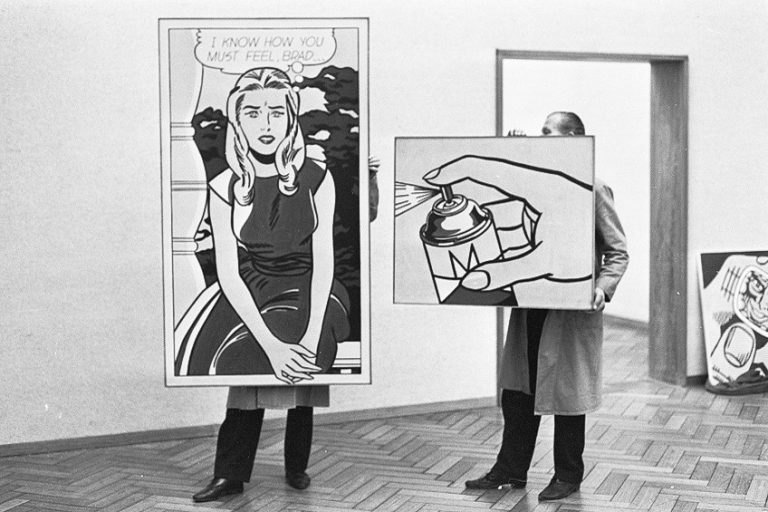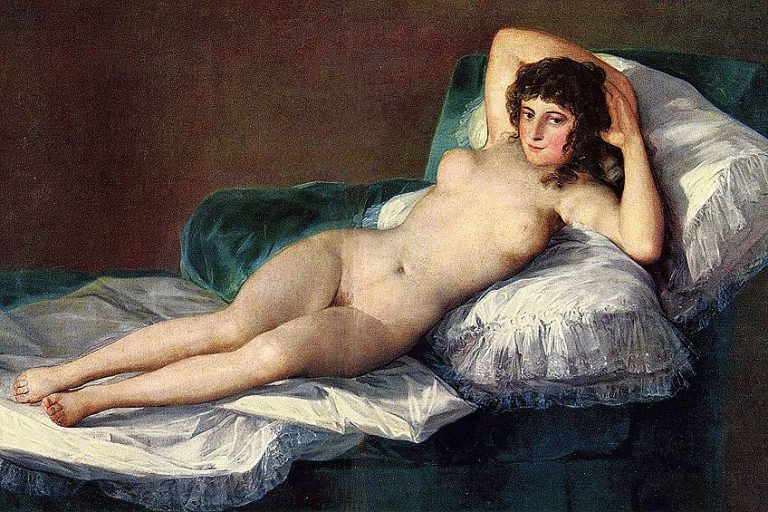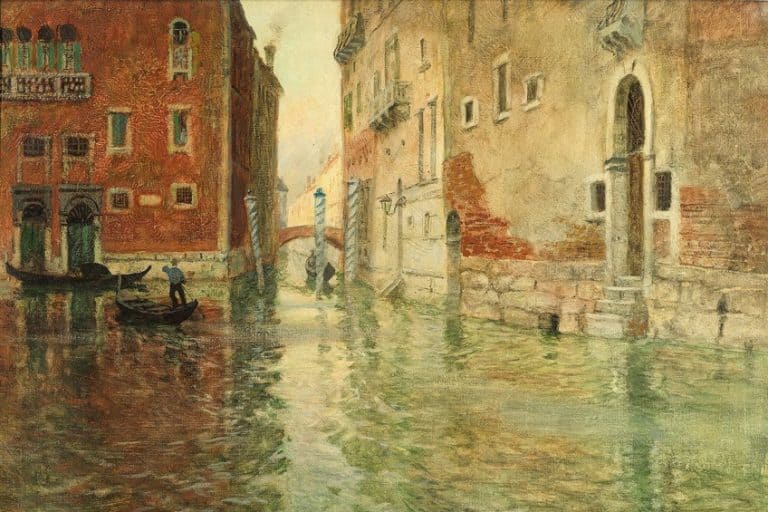Four Horsemen of the Apocalypse Dürer – An Analysis
The Apocalypse has been a common narrative in art history for many centuries, especially during the period that was marked as the Renaissance, around the 1500s. It was a widespread theme for religious paintings and other forms of art like woodcuts, which is what we will look at in this article, specifically The Four Horsemen of the Apocalypse woodcut by the Northern Renaissance artist, Albrecht Dürer.
Artist Abstract: Who Was Albrecht Dürer?
Albrecht Dürer was a prominent Northern Renaissance artist. He was born in Nuremberg, Germany on 21 May 1471. He was a painter, engraver, printmaker, and publisher of his own books, who learned from his father’s own Goldsmithing practice and successful publishing business. In 1486, Dürer began apprenticing under Michael Wolgemut. He traveled extensively across Europe and spent time in Italy where he learned new art techniques, which influenced his work in Germany.
While he traveled in Italy, he was acquainted with the Italian Renaissance masters like Leonardo da Vinci, Raphael, and others. He left a legacy inspiring many artists especially within the printmaking field of art.

The Four Horsemen of the Apocalypse by Albrecht Dürer In Context
Albrecht Dürer’s The Four Horsemen of the Apocalypse was part of – the third – his series of woodcuts illustrating the Biblical prophecies regarding the coming of the Apocalypse. It has been one his famous woodcuts made. Dürer was himself an outstanding and skilled artist of the Northern or German Renaissance period, also producing paintings and drawings with great attention to detail.
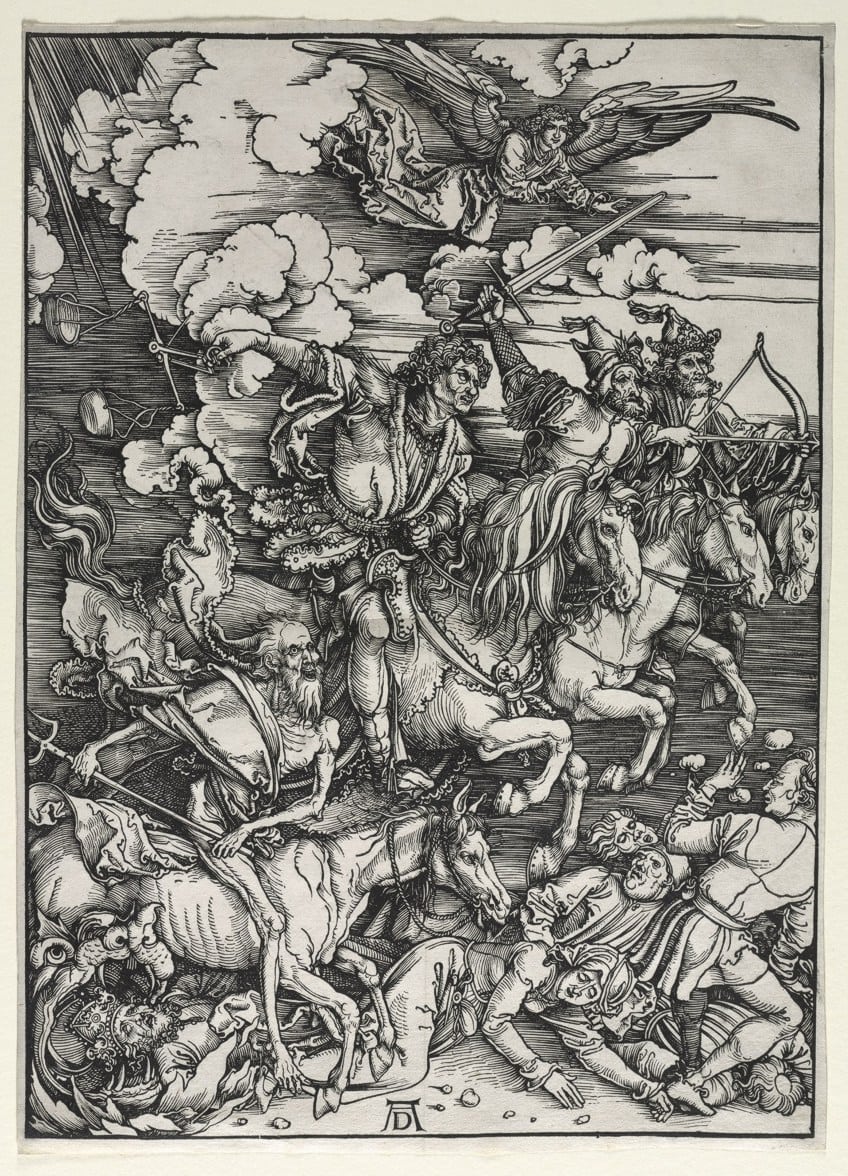
In the article below we discuss the above-mentioned woodcut by Dürer, we will first provide a brief contextual analysis, looking at what might have motivated him to produce these illustrations and we will explore questions such as, did Albrecht Dürer paint The Four Horsemen of the Apocalypse? What are the Four Horsemen? What do the Four Horsemen represent? Why did Albrecht Dürer make the Four Horsemen woodcut? And where is The Four Horsemen of the Apocalypse by Albrecht Dürer located?
We will then provide a formal analysis by taking a closer look at the subject matter and how Dürer portrayed this apocalyptic scene, including the technique of woodcutting and the artist’s great skill at crafting it.
| Artist | Albrecht Dürer |
| Date Painted | 1498 |
| Medium | Woodcut |
| Genre | Religious art |
| Period / Movement | Northern Renaissance |
| Dimensions | 38.8 x 29.1 centimeters |
| Series / Versions | Part of the woodcut series, The Apocalypse |
| Where Is It Housed? | The Metropolitan Museum of Art (MET), New York City, United States |
| What It Is Worth | Not available |
Contextual Analysis: A Brief Socio-Historical Overview
During the 15th century, Albrecht Dürer produced what was reportedly his first illustrated book, titled Apocalypse. He published it in 1498 but apparently started working on it when he was in Italy from 1494 to 1495, which was also his first visit to Italy.
It is important to note that within the overall history of the Renaissance, Dürer’s visit to Italy was an important marker in his art career as well as for the evolution of the Northern Renaissance. He learned a tremendous amount from the Italian Renaissance artists, including the characteristic techniques like sfumato and chiaroscuro; he visited Italy again from 1505 to 1507.

Going back to Dürer’s publication, it comprised 15 illustrations from the Bible’s Book of Revelations, and all were made as woodcut prints. There was also accompanying text, which was published in German and Latin. The layout of the Apocalypse book consisted of text on the left pages, in Latin, this is referred to as verso, and the illustrations were on the right pages, similarly, in Latin, this is referred to as recto.
“Half Time After the Time”: The End of the World?
When we look at the question, “What do the Four Horsemen represent?”, we need to consider what people during the 15th century believed about the world. This was still the Medieval ages and Christianity was the dominant religion. In Europe, many believed that the world would end by 1500 and the apocalypse would begin.
The term “Half time after the time” comes from the Bible’s “Book of Revelation”, which also incited a lot of fears about the end of the world.
There were various other forces at play that influenced these fears, namely, the Italian preacher and prophet Girolamo Savonarola who preached about the rich exploiting the poor. His prophecy about Italy’s invasion by King Charles III of France also came true, which led many to believe his outcries. Among those who followed Savonarola was the Renaissance artist Alessandro Botticelli. The artist reportedly burned some of his paintings in what was known as the Bonfire of the Vanities in 1497.
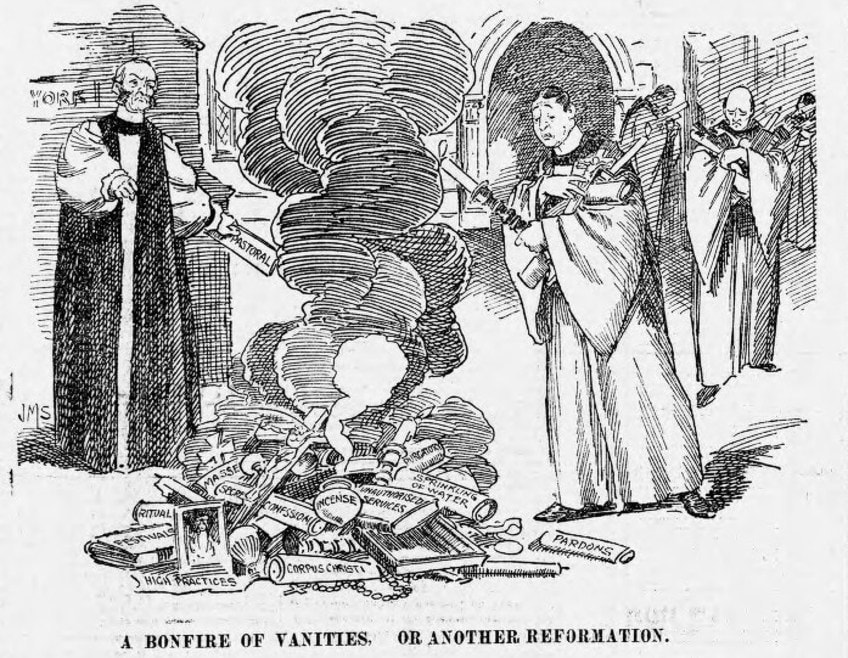
This was because of the preacher’s beliefs about how art was a luxury for the rich and had mythological themes and should be rid of. However, this has been debated as Botticelli was believed to have painted a few works after the prophet’s death in 1498.
With all these fervent religious prophecies and outcries in Italy, it comes as no surprise as to why Albrecht Dürer made The Four Horsemen of the Apocalypse. He would have been influenced by the religious fervor of the time especially taking into consideration that he visited Italy and would have gained some level of firsthand knowledge.
What Are the Four Horsemen?
Before we look at Dürer’s woodcut, The Four Horsemen of the Apocalypse let us provide some backstory and explore the question around, what do the Four Horsemen represent? As mentioned above, the Four Horsemen originate from the Bible’s Book of Revelation, specifically from the prophecy concerning the Seven Seals.
Also referred to as the Seven Seals of God, it is introduced from Chapter Five in Revelations. The Seven Seals is a book or scroll that, when opened, will commence the Apocalypse and thus the Second Coming of Christ.
The first four seals are the Four Horsemen. According to the Bible, from the New King James Version, in Chapter Six the author, John of Patmos, describes each seal. When the Lamb opened the seals, he was called to “Come and see” by each of the creatures that came out.
When the First Seal was opened, he explained, “And I looked, and behold, a white horse. He who sat on it had a bow, and a crown was given to him, and he went out conquering and to conquer”. The first horse was referred to as “The Conqueror”.
The Second Seal unleashed the second horse referred to as “War” and the author described, “Another horse, fiery red, went out. And it was granted to the one who sat on it to take peace from the earth, and that people should kill one another; and there was given to him a great sword”.
The Third Seal unleashed “Famine” and the author described, “So I looked, and behold, a black horse, and he who sat on it had a pair of scales in his hand. And I heard a voice in the midst of the four living creatures saying, ‘A quart of wheat for a denarius, and three quarts of barley for a denarius; and do not harm the oil and the wine’”.
The Fourth Seal unleashed “Death” and the author described, “So I looked, and behold, a pale horse. And the name of him who sat on it was Death, and Hades followed with him. And power was given to them over a fourth of the earth, to kill with sword, with hunger, with death, and by the beasts of the earth”.
We will find the Four Horsemen symbols are their weapons and this part of the Book of Revelations has been one of the most widespread images.
There are numerous The Four Horsemen of the Apocalypse painting examples, namely the Russian artist Viktor Vasnetsov’s painting, titled Four Horsemen of the Apocalypse (1887). As we see from Dürer’s woodcut print, it is black and white, and in paintings, we can view the Four Horsemen in their respective colors. In Vasnetsov’s Four Horsemen of the Apocalypse painting version, he depicts the Four Horsemen in successive order and in their respective colors with their weapons. We see the white Lamb of God in the sky directly above the apocalyptic scene.
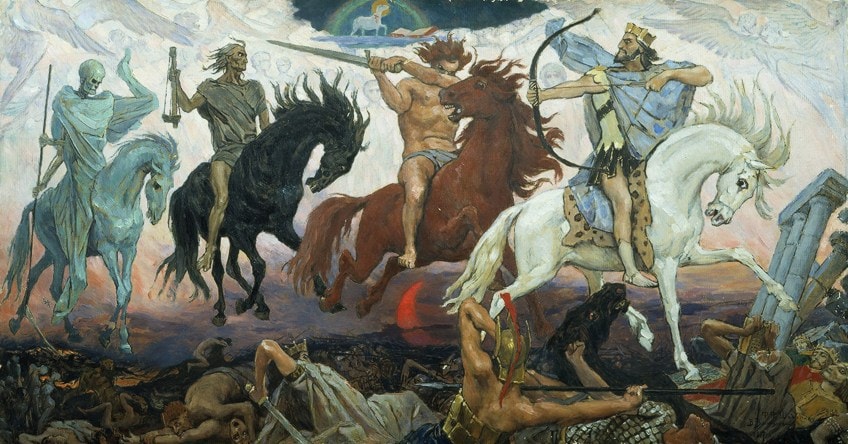
Formal Analysis: A Brief Compositional Overview
Now we have more understanding about who the four main protagonists are in Dürer’s woodcut, namely Conquest, War, Famine, and Death respectively. This includes their contributing characteristics, or otherwise the Four Horsemen symbols, which are their weapons. Below we discuss Dürer’s composition and technique further.
Subject Matter
If we start from the top of the composition, there is a robed angel with large wings above the riders who appears to be guarding over the scene or the riders. Furthermore, there are thick spots of clouds in the sky and seemingly behind the riders, almost like smoke behind them as they gallop into the scene.
In the top left corner, there are sharp radiating lines denoting rays of light – the heavens are opened, and the Apocalypse is set, the scene is divinely dramatic above and chaotic below.
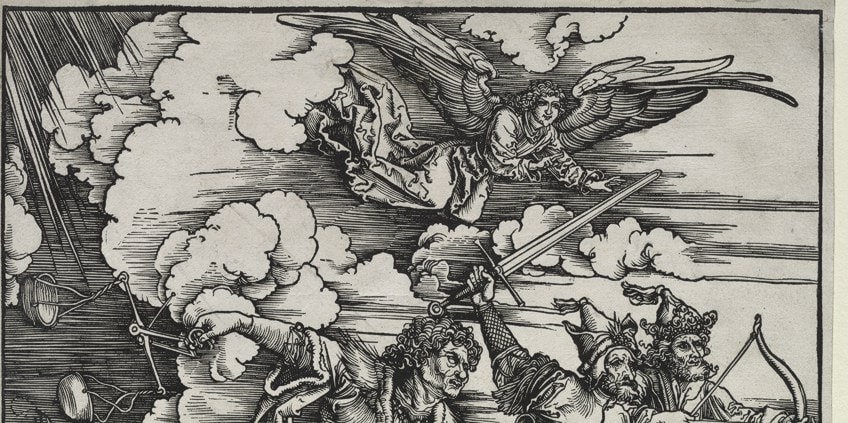
At first glance we might not know where to start amidst the chaos, however, in The Four Horsemen of the Apocalypse Dürer depicts each rider in Biblical order. Starting from the far left (our right) in the background we see the First Rider, “Conquest”; he is on his horse holding his bow, which has an arrow in it, and ready to shoot. He wears what appears like a crown with a tassel on the tip of his head covering.
The riders almost overlap one another. Moving closer towards the foreground, next to the First Rider, is the Second Rider, “War”, holding up his long sword in his right hand ready to strike.
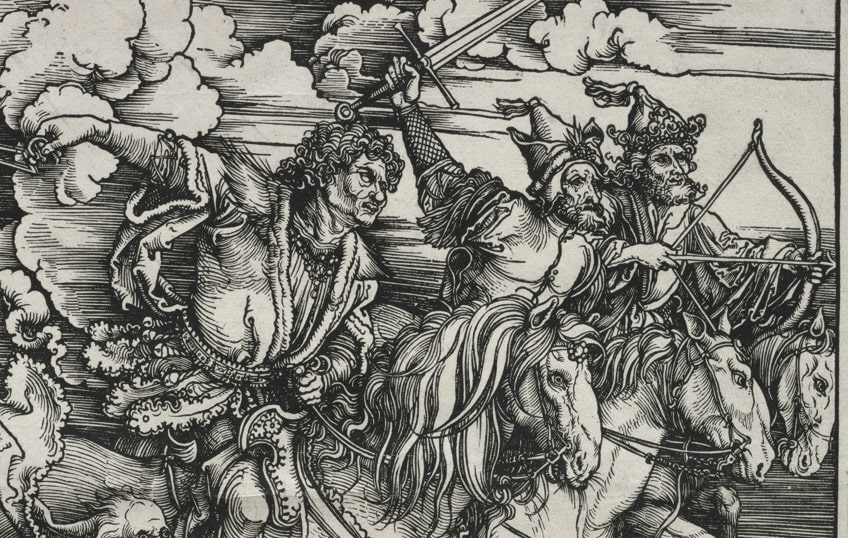
From a visual perspective and compositional arrangement of the subject matter, the sword is directly below the outstretched left hand of the Angel above, making it seem as if the angel might touch the sword at any moment, however, this was probably not intended by the artist and merely gives us a reference point as to where the figures are situated.

The Third Rider, “Famine”, appears closer to us as move to the foreground. He holds a set of scales or balances in his right hand, which is stretched out behind him as if he is preparing to swing his balances outwards. As part of the Four Horsemen symbols, the scales are not a weapon like the others, however, their effects are deadly.
In the near foreground is the Fourth Rider, “Death”. We see him in more detail than the other riders. He holds a trident in both hands, alongside the right side (our left) of his body. He appears as an emaciated elderly man with a long beard. Similarly, his horse is also emaciated, shown by his protruding ribcage.
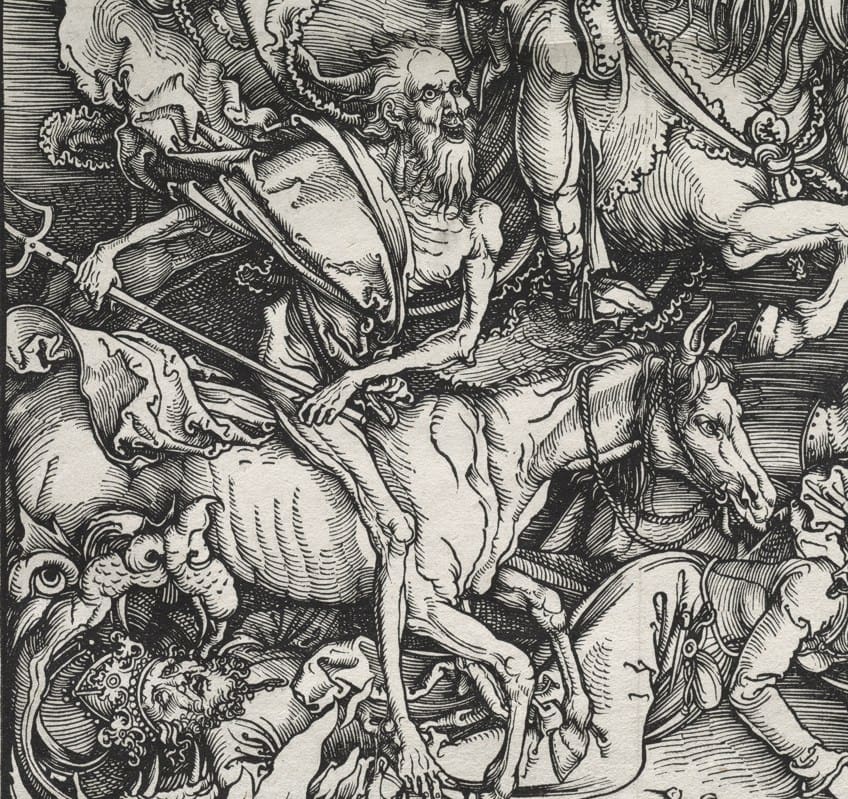
Although the other three riders are wearing clothing and headdresses, the fourth rider is presented as seemingly bare, only wearing a tattered cloth around him. We see it around the top part of his torso, the rest of it appears to be flowing in the wind behind him. It is important to note that the Bible did not describe Death with a weapon, but here Dürer gives him a trident, possibly for a sense of continuation due to the other three having weapons.
However, we could assume Death is the weapon himself as he was given the task to kill alongside his three Apocalyptic compatriots.
Directly below Death, in the bottom left corner of the composition, is a dragon-like creature with large fangs. He is about to bite down on what appears to be the figure of a Bishop lying headfirst in his large mouth, his body being trampled by the hooves of Death’s horse.

The Four Riders are entering the scene with great haste as if driven by a propelling force that will stop them for no one. Their horses are trampling on various figures lying below them on the ground, ensuring a chaotic carnage. We see one figure still standing, his left hand is up in a reflex of shielding himself while trying to get away, but this seems an impossible task and he will soon be among those bodies lying on the ground.

With Great Skill: Albrecht Dürer’s Woodcut Technique
Albrecht Dürer was not just a painter that managed to create artworks with great attention to detail, but his keen eye was adept at creating designs for woodcuts. The woodcut technique has been around since reportedly the 1400s, which was during the Early Renaissance period.
This was also a time when printmaking became more widespread giving woodcuts more prominence.
Woodcutting consisted of using a piece of wood, or block of wood, which was then carved according to the respective image. The image carved would have been raised after the surrounding wood was carved away, or the “negative space” so to say. This undoubtedly would have required skill and craftsmanship to create a perfect image.
Once the woodcut was carved the raised images would have been inked and pressed onto paper, which would have then been used in the printmaking process. This is a rough example of the process of printmaking and woodblock techniques.
With this, Dürer reportedly utilized what was believed to be pearwood. There are various sources that explore the question of whether Dürer personally carved the woodcut or if a craftsman did this.
Whatever the case was, Dürer was remembered as seemingly upending the craft of woodcuts because of his detailed designs consisting of fine lines and textural ranges. Woodcuts before this consisted of bulkier lines and cuts.
Color and Shading
Dürer creates distinction here by using the Four Horsemen symbols, but what does this mean? Simply, because the Four Horsemen are described in the Bible in terms of their horses’ colors, for example, “white”, “fiery red”, “black”, and “pale”, and the woodcut is black-and-white, Dürer created the woodblock so that we could distinguish the four horses respectively.
The Four Horsemen symbols illustrate to us who the horsemen are in the composition. Furthermore, Dürer also depicted them in Biblical order. Without their colors, we can easily spot their characters as described in the Bible.
Additionally, we are further shown Dürer’s great skill in the smaller areas of shadows throughout the composition. Dor example, in shaded areas like the riders’ necks, inside their open billowing sleeves, or the tonality of the rider’s scales, suggesting they are made from metal.
Line
In The Four Horsemen of the Apocalypse, Dürer depicts detailed lines and tonal shifts throughout the composition. If we look at the background, there are numerous fine lines creating a darkened area, which also provides a sense of space and depth. There are lighter clouds depicted in this darker space, which adds to the ambiance as the Four Riders enter the scene from the left.
The lines of the background create the effect of movement and we almost feel as if the riders are rushing into the scene resolute on their purpose ahead of them.
All these minute details give the composition a three-dimensional quality without utilizing any shades or tones of colors at all. What makes the woodcut so unique is that we are able to zoom in on areas and each line appears perfectly executed.

Forever Engraved
Albrecht Dürer influenced many artists to come during the centuries, for example, the Renaissance Raphael and the Renaissance and Mannerist artist we all know as Titian. These two artists were influenced by Dürer’s printmaking skills, but there were numerous others including the well-known Hans Baldung Grien, who was one of Dürer’s pupils.
Some of Dürer’s other famous artworks include his watercolor and gouache Young Hare (1502), which depicts his characteristic keen eye for detail. His famous ink and pencil drawing, Praying Hands (1508), and various other paintings, for example, his famous self-portrait oil painting Self-Portrait at Twenty-Eight (1500), which has been likened to the resemblance of Jesus Christ.
Albrecht Dürer’s epitaph reportedly states, “Whatever was mortal of Albrecht Dürer lies beneath this mound”. His art, now immortalized, will always be remembered, and forever engraved in the art world. Dürer will also always be remembered as an artist of many talents and skills, especially one who created new scopes and standards in woodcuts and printmaking. He died when he was 56 years old, on the 6th of April 1528, in his home country Nuremberg in Germany.
Frequently Asked Questions
Where Is The Four Horsemen of the Apocalypse by Albrecht Dürer Located?
The woodcut The Four Horsemen of the Apocalypse (1498) by Albrecht Dürer is now housed in the Metropolitan Museum of Art (MET) in New York City, the United States.
Why Did Albrecht Dürer Make The Four Horsemen of the Apocalypse?
The Four Horsemen of the Apocalypse (1498) by Albrecht Dürer was made as part of his publication titled Apocalypse (1498). This consisted of 15 illustrations inspired by the Book of Revelations in the Bible. It is believed that it could have been due to the events in Europe during the 15th century when many believed the end of the world would come in the year 1500 as well as threatening wars and invasions from other countries.
When Did Albrecht Dürer Paint The Four Horsemen of the Apocalypse?
Albrecht Dürer created The Four Horsemen of the Apocalypse in 1498, however, this is a woodcut part of his series of other woodcuts that comprise his publication Apocalypse (1498). He was believed to have started on the series when he traveled to Italy from his home in Nuremberg from 1494 until 1495. This was also during the time of the Renaissance in Italy, and Dürer was a leading artist of the Northern Renaissance.
What Do the Four Horsemen Represent?
In The Four Horsemen of the Apocalypse Dürer represents the Four Horsemen or Riders, who are from Chapter Six in the Book of Revelation in the Bible. In this, the author, believed to be John of Patmos, narrates about the prophecy of the Seven Seals and the Four Horsemen are the First Four Seals unleashed on the world. The Four Horsemen represent different aspects that bring on the Apocalypse, namely, “Conquest”, “War”, “Famine”, and “Death”, respectively. They are also represented with their own weapons and their horses are described by their colors.
Isabella studied at the University of Cape Town in South Africa and graduated with a Bachelor of Arts majoring in English Literature & Language and Psychology. Throughout her undergraduate years, she took Art History as an additional subject and absolutely loved it. Building on from her art history knowledge that began in high school, art has always been a particular area of fascination for her. From learning about artworks previously unknown to her, or sharpening her existing understanding of specific works, the ability to continue learning within this interesting sphere excites her greatly.
Her focal points of interest in art history encompass profiling specific artists and art movements, as it is these areas where she is able to really dig deep into the rich narrative of the art world. Additionally, she particularly enjoys exploring the different artistic styles of the 20th century, as well as the important impact that female artists have had on the development of art history.
Learn more about Isabella Meyer and the Art in Context Team.
Cite this Article
Isabella, Meyer, “Four Horsemen of the Apocalypse Dürer – An Analysis.” Art in Context. December 7, 2021. URL: https://artincontext.org/four-horsemen-of-the-apocalypse-durer/
Meyer, I. (2021, 7 December). Four Horsemen of the Apocalypse Dürer – An Analysis. Art in Context. https://artincontext.org/four-horsemen-of-the-apocalypse-durer/
Meyer, Isabella. “Four Horsemen of the Apocalypse Dürer – An Analysis.” Art in Context, December 7, 2021. https://artincontext.org/four-horsemen-of-the-apocalypse-durer/.




